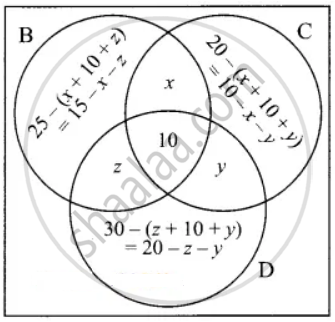Advertisements
Advertisements
Question
In a class of 50 students, each one come to school by bus or by bicycle or on foot. 25 by bus, 20 by bicycle, 30 on foot and 10 students by all the three. Now how many students come to school exactly by two modes of transport?
Solution
Let B, C and D represent students come to school by bus, bicycle and foot respectively.
n(B ∪ C ∪ D) = 50, n(B) = 25, n(C) = 20, n(D) = 30, n(B ∩ C ∩ D) = 10
Let x, y and z represent the students come to school exactly by two modes of transport.
Let us represent the given data in Venn diagrams.
Total number of students in the class = 50
15 – x – z + x + 10 – x – y + y + 10 + z + 20 – z – y = 50
55 – x – y – z = 50
55 – 50 = x + y + z
5 = x + y + z
Number of students come to school exactly by two modes of transport = 5
APPEARS IN
RELATED QUESTIONS
Write the cardinal number of the following set:
B = {-3, -1, 1, 3, 5, 7}
Write the cardinal number of the following set:
F = {Whole numbers from 8 to 14}
Given:
A = {Natural numbers less than 10}
B = {Letters of the word ‘PUPPET’}
C = {Squares of first four whole numbers}
D = {Odd numbers divisible by 2}.
Find: n(C ∩ D)
Given:
A = {Natural numbers less than 10}
B = {Letters of the word ‘PUPPET’}
C = {Squares of first four whole numbers}
D = {Odd numbers divisible by 2}.
Find: n(B ∪ C)
Given:
A = {Natural numbers less than 10}
B = {Letters of the word ‘PUPPET’}
C = {Squares of first four whole numbers}
D = {Odd numbers divisible by 2}.
Find: n(A ∪ D)
Verify n(A ∪ B ∪ C) = n(A) + n(B) + n(C) – n(A ∩ B) – n(B ∩ C) – n(A ∩ C) + n(A ∩ B ∩ C) for the following sets
A = {a, c, e, f, h}, B = {c, d, e, f} and C = {a, b, c, f}
In a class, all students take part in either music or drama or both. 25 students take part in music, 30 students take part in drama and 8 students take part in both music and drama. Find the number of students who take part in only music
In a party of 45 people, each one likes tea or coffee or both. 35 people like tea and 20 people like coffee. Find the number of people who do not like coffee
Out of 500 car owners investigated, 400 owned car A and 200 owned car B, 50 owned both A and B cars. Is this data correct?
Each student in a class of 35 plays atleast one game among chess, carrom and table tennis. 22 play chess, 21 play carrom, 15 play table tennis, 10 play chess and table tennis, 8 play carrom and table tennis and 6 play all the three games. Find the number of students who play only chess (Hint: Use Venn diagram)
